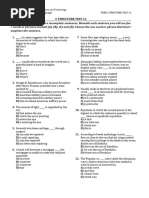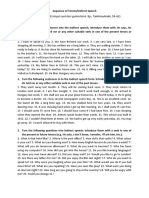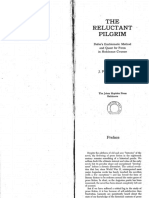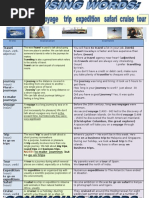0 ratings0% found this document useful (0 votes)
85 viewsHEL - I - 2 - Defoe - Robinson Crusoe
HEL - I - 2 - Defoe - Robinson Crusoe
Uploaded by
Steven MartinDefoe's Robinson Crusoe is considered the first English novel. Published in 1719, it was based on the true story of Alexander Selkirk, who lived alone on an uninhabited island for four years. The novel follows Robinson Crusoe as he is shipwrecked on an island, where he must learn to survive on his own and create the necessities of life. Through his experiences, he becomes deeply religious and sees his isolation as a form of repentance. The story also represents Enlightenment ideas of rationalism and the power of individual reason and labor. Robinson Crusoe established the genre of desert island fiction.
Copyright:
© All Rights Reserved
Available Formats
Download as PPT, PDF, TXT or read online from Scribd
HEL - I - 2 - Defoe - Robinson Crusoe
HEL - I - 2 - Defoe - Robinson Crusoe
Uploaded by
Steven Martin0 ratings0% found this document useful (0 votes)
85 views25 pagesDefoe's Robinson Crusoe is considered the first English novel. Published in 1719, it was based on the true story of Alexander Selkirk, who lived alone on an uninhabited island for four years. The novel follows Robinson Crusoe as he is shipwrecked on an island, where he must learn to survive on his own and create the necessities of life. Through his experiences, he becomes deeply religious and sees his isolation as a form of repentance. The story also represents Enlightenment ideas of rationalism and the power of individual reason and labor. Robinson Crusoe established the genre of desert island fiction.
Original Description:
goof
Original Title
HEL_I_2_Defoe_Robinson Crusoe
Copyright
© © All Rights Reserved
Available Formats
PPT, PDF, TXT or read online from Scribd
Share this document
Did you find this document useful?
Is this content inappropriate?
Defoe's Robinson Crusoe is considered the first English novel. Published in 1719, it was based on the true story of Alexander Selkirk, who lived alone on an uninhabited island for four years. The novel follows Robinson Crusoe as he is shipwrecked on an island, where he must learn to survive on his own and create the necessities of life. Through his experiences, he becomes deeply religious and sees his isolation as a form of repentance. The story also represents Enlightenment ideas of rationalism and the power of individual reason and labor. Robinson Crusoe established the genre of desert island fiction.
Copyright:
© All Rights Reserved
Available Formats
Download as PPT, PDF, TXT or read online from Scribd
Download as ppt, pdf, or txt
0 ratings0% found this document useful (0 votes)
85 views25 pagesHEL - I - 2 - Defoe - Robinson Crusoe
HEL - I - 2 - Defoe - Robinson Crusoe
Uploaded by
Steven MartinDefoe's Robinson Crusoe is considered the first English novel. Published in 1719, it was based on the true story of Alexander Selkirk, who lived alone on an uninhabited island for four years. The novel follows Robinson Crusoe as he is shipwrecked on an island, where he must learn to survive on his own and create the necessities of life. Through his experiences, he becomes deeply religious and sees his isolation as a form of repentance. The story also represents Enlightenment ideas of rationalism and the power of individual reason and labor. Robinson Crusoe established the genre of desert island fiction.
Copyright:
© All Rights Reserved
Available Formats
Download as PPT, PDF, TXT or read online from Scribd
Download as ppt, pdf, or txt
You are on page 1of 25
The First English Novel
Daniel Defoe (1660–1731) did not apply the term novel
to his writings; still, he lay down a set of narrative
conventions that assign the merit of the first novel
written in English to him.
Defoe’s Literary Activity
Defoe had various jobs before he started his literary
activity: entrepreneur, a pamphleteer, as a secret agent
and he often encountered serious financial problems. He
worked for several journals and newspapers.
Essay on Projects: proposals referring to social
improvement, emphasizing the importance of education.
The True-Born Englishman: is satire in verse.
The Shortest Way with the Dissenters: a pamphlet directed
against the Tories, because of which he was sentenced to
prison.
After being released, he started his own enterprise as a
journalist, founding the periodical entitled The Review.
Defoe’s Literary Activity
He turned to writing novels at an old age; he was
almost sixty when he wrote Robinson Crusoe, which
was followed by Moll Flanders, Journal of the Plague
Year, Captain Singleton, Colonel Jack and Roxana.
Defoe’s journalistic activity exercised a strong
influence on the style of his novels.
Robinson Crusoe
Robinson Crusoe (1719): the prototype of the modern
English novel, though the author does not consider it a
novel; in The Author’s Preface the terms “story”, “account”,
“history” and “fact” are used.
The work is offered to the reader as an authentic material
of a series of real life experiences rather than fiction: “the
editor believes the thing to be a just history of fact; neither
is there any appearance of fiction in it”.
anonymous author
The explicit purpose of the work is to instruct the reader,
to transmit the moral message, in accordance with the
literary fashion of the time.
Robinson Crusoe
Today it is mainly classified as belonging to youth
literature. However, this categorization cannot
diminish its importance as embodying a modern
myth, a milestone of modern culture and civilization.
In this respect, Robinson embodies the archetype of
the modern individual, a creator of civilization.
Robinson Crusoe
The story is inspired by a true adventure of a sailor
called Alexander Selkirk, who accompanied the
famous voyager Dampier in a journey around the
world.
As a consequence of the quarrel between the two,
Selkirk was left for disobedience on the uninhabited
island of Juan Fernandez.
He lived there for about five years when he was saved
by Captain Woodes, who wrote a book entitled A
Journey Around The World.
Storyline
The novel is a first-person account of the adventures
and experiences of the main hero. It starts by
presenting Robinson Crusoe, his birth and education,
his running away from home against his father’s will
in search of adventure. He makes several voyages,
during one of them he is caught by pirates, then sold
as a slave, he escapes and becomes a rich plantation
owner and slave-trader in Brazil. On his journey to
Africa he is shipwrecked and washed ashore on an
uninhabited island, where he spends approximately
twenty-eight years.
Storyline
His island experience is a short version of the history of
mankind. He goes through several phases. At the
beginning he sleeps on a tree, but gradually he has to
recreate the necessities of human life. He adapts himself
to the circumstances by building a raft, building his house,
making provisions and domesticating goats.
In the second phase he explores the island: he builds a
boat and sails around the island. He discovers footprints in
the sand and is alarmed by the idea that there might be
cannibals visiting the island. In the third phase he rescues
Friday, civilizes him and makes plans for leaving the
island. Eventually he is rescued and returns to England.
Allegory
Robinson’s story follows the allegorical tradition
established by Bunyan’s novel, but here the allegory is
twofold.
Christian allegory, (the name Crusoe: allusion to the cross,
to Christianity);
modern allegory of civilization, starting from the
mythological origins of the human race, reaching a high
level of civilization (Crusoe: cruise, that is, exploration, sea
voyage, discovery).
In this sense, Providence and Reason are the two main
characters of the narrative allegory; the two powers, an
outer force and an inner drive that pave the way for the
individual’s survival and self-discovery.
Religious Allegory
conversion of an initially sinful individual, who used
to object to the authority of his father, but whose
experiences on the island turn him into a deeply
religious person.
Biblical inspiration; it resorts to the motif of the
prodigal son. During his experiences and his
continuous reflections on them, Robinson becomes a
devoted reader of the Bible, who interprets his
isolation as a form of repentance for his sinful past, as
a series of “miracles”, moral lessons offered by
Providence.
Religious Allegory
Providence: God’s worldly manifestation, as the
divine power that is directly “responsible” for one’s
fate. Robinson submits himself to God’s will and
appeals to Providence to help him face the difficulties.
He interprets every positive aspect of his situation as
the direct manifestation of God’s goodness and
mercy. His religious belief is very practical, based on
the conviction that God helps especially those who
help themselves – thus proving the influence of
Puritanism.
Worldly Allegory
Robinson Crusoe: representative of mankind, who alone,
relying on his own intellectual and physical capacities,
manages to dominate over the circumstances.
The island is the place where the individual undergoes a
series of experiences that contribute to his religious and
moral transformation, metamorphosis.
The individual capacities are tested; Robinson’s story of
survival testifies his capacity of creating a civilized life
similar to the one he left behind. Robinson passes the test
because of his strong will and powerful reason. He works
out a strategy of survival.
Enlightenment Ideas
Robinson: optimism and enthusiasm of the
Enlightenment.
embodiment of the Man of Reason, of the exemplary
man endowed with common sense, whose attitude is
for others to follow.
He is conscious of his intellectual capacities, he
considers that by careful observation and proper
judgment everybody can possess the skills he was
forced to develop in himself.
Enlightenment Ideas
As a practical philosopher of the Enlightenment, Robinson
considers that reason represents an essential value; it is the
basic condition of survival. His intellect unifies the qualities of
both an empiricist and a rationalist thinker; as an empiricist,
he gathers his observations and he relies on them and as a
rationalist, he is capable of deductive thinking too.
He is capable of drawing conclusions from his experiences. He
strives for understanding the world that surrounds him, and he
tries hard to overwhelm the fear of the unknown by reason.
He is an analytic mind, he keeps weighing the advantages and
disadvantages of his situation, and he seeks consolation in the
fact that it could be much worse, in the fact that there are a
great deal of positive things in his desperate situation.
Enlightenment ideas
In the struggle for life, reason must be completed by
consistent effort, Robinson’s tale suggests. The importance
of labour is highlighted throughout the narrative.
Robinson is the homo economicus, the active and
enterprising middle-class merchant, who needs and
creates material values and who praises the importance of
manual work.
the white colonizer: his relationship to Friday is that of
the master and servant, which is presented in a way that
subduing the primitive man seems to be the most proper
thing in the world. He regards Friday as his own rightful
property; in his view Friday has a black skin but a “white
soul”. Friday is taught to obey him; the first words that he
learns are “yes” and “master”.
Robinson’s Character
Besides his intelligence, his basic features that help him
survive are his adaptability and self-reliance.
He is a good organizer and he claims order; measures
and quantities are extremely important to him. He
measures the passage of time by means of a calendar;
dates are of particular interest to him. He is preoccupied
by coincidences: the day his journal starts with, 30th of
September 1659, stands for his birthday at the same time.
Coincidences are for him the evidence of an invisible
transcendental power that guides one’s fate. The loss of
time would mean the loss of the self.
Narration
Robinson Crusoe contains no chapters, it is a continuous
account of the narrator; it is only the journal that is
intercalated.
first-person narrative; this technique renders the hero’s
thoughts and feelings in an authentic way, in a simple,
matter-of-fact style, conveying the illusion of truth.
retrospective narrator, relating the experiences of his
past self. Because of the distance between the time of
narration and narrated time, the first-person narrator
struggles hard to express the past emotions in a proper
way.
Desert Island Fiction
Robinson Crusoe’s afterlife seems to be as significant
as the novel itself (this does not apply to the sequel
which appeared one year later, under the title of
Farther Adventures of Robinson Crusoe; it does not
attain the level of the previous novel).
Defoe’s work represents a crucial moment in the
process of development of the novel form; it gave
birth to a literary genre still very popular today, called
Robinsonade or desert island fiction.
Desert Island Fiction
Inspired by the theme of Robinson, desert island fiction
chooses the scene of a distant island, which may serve
various literary purposes: it may represent the natural
environment untouched by man, the primitive setting
unspoilt by civilization, or the exotic, the unusual, the
imaginary scene, highly different from real life.
The notion of adventure is closely connected to this
setting, where the individual – or a group of people – have
to prove their capacities of adapting to the hostile
circumstances, based on self-knowledge and self-control
(e.g. in today’s television shows – reality shows, survival
shows – the desert island serves as the venue of ultimate
test).
Desert Island Fiction
The term Robinsonade is of German origin, and the French
term Robbinsonnades was also born, together with the series
of imitations that were published not much after Defoe’s
novel appeared.
One year after its publication, Defoe’s Robinson Crusoe was
translated into German, and several imitations followed:
Johann Schnabel’s Die Insel Felsenburg (1731–43)
Johann Campe’s Robinson der Jüngere (1779–80),
Johann Wyss’s Der schweizerische Robinson (1812–27),
translated into English under the title of The Swiss Family
Robinson in 1814.
Desert Island Fiction
The topic became a children’s favourite in the
nineteenth century European literature:
J Taylor’s The Young Islanders (1841),
Jules Verne’s L’Île mystérieuse (1875),
R.M. Ballantine’s The Coral Island (1858),
R.L. Stevenson’s Treasure Island (1883)
Desert Island Fiction
The topic survived into the twentieth century modernist
literature as well. The most notable works to be
mentioned are William Golding’s Lord of the Flies (1954),
Aldous Huxley’s Island (1966) and Michel Tournier’s
Vendredi (1967).
Instead of an individual, who – based primarily on his
intelligence –, is capable of attaining the level of a civilized
life, Golding’s dystopia presents the story of a group of
children, who, led by their instincts, destroy all values –
community values, individual values, basic human values –
that they still possessed at the moment of being cast on
the island. Golding’s vision reflects modern man’s
alienation, not only from the natural and cultural
environment, but also from his own self.
Desert Island Fiction
By a side-by-side reading of Robinson Crusoe and The Lord
of the Flies, the reader may grasp the distance between the
optimism of the Enlightenment and the dark pessimism
characteristic of modernism; between the views of the
constructing vs. destroying powers of man.
Defoe: the individual creating civilization; Golding: the
individual, being part of a community and bearing the
negative effects of civilization, is only capable of self-
destruction.
A more recent, utterly original rewriting of the theme,
from a female point of view: J.M. Coetzee’s Foe (1986).
Thank you for your attention!
You might also like
- TOEFL Structure Test 12Document4 pagesTOEFL Structure Test 12ailehesabi85No ratings yet
- Stranded On A Desert Island Lesson PlanDocument15 pagesStranded On A Desert Island Lesson PlanDespina Karamitsou75% (4)
- Colonialism in Robinson Crusoe by DefoeDocument2 pagesColonialism in Robinson Crusoe by DefoeDaffodil100% (3)
- Summary of Robinson CrusoeDocument4 pagesSummary of Robinson Crusoeellen2067% (3)
- Message in A Bottle Lesson PlanDocument8 pagesMessage in A Bottle Lesson PlanKatalin VeresNo ratings yet
- Robinson CrusoeDocument2 pagesRobinson CrusoeMk.loveNo ratings yet
- 6 Robinson Crusoe Themes BookDocument39 pages6 Robinson Crusoe Themes BookNguyen The Huy100% (1)
- 7052A00023 NguyenThiThuNgan HoChiMinhDocument5 pages7052A00023 NguyenThiThuNgan HoChiMinhLê Nguyễn Xuan AnhNo ratings yet
- Daniel DefoeDocument5 pagesDaniel Defoelindapapaleo04No ratings yet
- Pacuretu Maria Simina Andrei Ana MariaDocument20 pagesPacuretu Maria Simina Andrei Ana MariaSamanthaFox28100% (1)
- Thesis On Robinson CrusoeDocument4 pagesThesis On Robinson Crusoeafjrqokne100% (2)
- Group 1 - Robinson CrusoeDocument8 pagesGroup 1 - Robinson CrusoePhương NguyễnNo ratings yet
- Robinson Crusoe by Daniel DefoeDocument3 pagesRobinson Crusoe by Daniel Defoesalim.raad2004No ratings yet
- Questions Robinson Crusoe TeacherDocument3 pagesQuestions Robinson Crusoe TeacherRodrigo Jappe100% (1)
- 4_6003846817853216215Document19 pages4_6003846817853216215yidaheb532No ratings yet
- Commentary Robinson Crusoe - OdtDocument4 pagesCommentary Robinson Crusoe - OdtAdriana AadrianaaNo ratings yet
- Robinson CrusoeDocument1 pageRobinson CrusoeDadi DadiNo ratings yet
- Postcolonial Analysis On Novel Robinson CrusoeDocument4 pagesPostcolonial Analysis On Novel Robinson CrusoeIan Chen0% (1)
- The Slavery Relationship Between Friday and Robinson Crusoe After Robinson Crusoe by D. Defoe: An EssayDocument5 pagesThe Slavery Relationship Between Friday and Robinson Crusoe After Robinson Crusoe by D. Defoe: An EssayHena KhanNo ratings yet
- Robinson Crusoe's Novel .Summarised by Mohammad AwanahDocument10 pagesRobinson Crusoe's Novel .Summarised by Mohammad Awanahعبدالرحمن المسلميNo ratings yet
- English NotesDocument7 pagesEnglish Notesfrancesca toniazzoNo ratings yet
- Nuovo Microsoft Word DocumentDocument1 pageNuovo Microsoft Word DocumentFranco TibertiNo ratings yet
- English Literature 4th YearDocument9 pagesEnglish Literature 4th Year902088No ratings yet
- Realism in Defoe's Robinson CrusoeDocument19 pagesRealism in Defoe's Robinson CrusoeAbdullah alta'yNo ratings yet
- Niloy Mukherjee CC8Document5 pagesNiloy Mukherjee CC8xihsoumi.chatterjiNo ratings yet
- Refer at AsDocument8 pagesRefer at AsazoresfranceNo ratings yet
- 2 Novel Defoe Swift RichardsonDocument6 pages2 Novel Defoe Swift Richardsonm.sole.lombardiNo ratings yet
- Robinson CrusoeDocument1 pageRobinson Crusoeemanuelanovelli6No ratings yet
- Robinson Crusoe Thesis StatementDocument4 pagesRobinson Crusoe Thesis StatementHelpWithWritingAPaperSiouxFalls100% (2)
- Robinson Crusoe's AnalysisDocument4 pagesRobinson Crusoe's Analysisqinaz IrNo ratings yet
- Realism in The Novel Robinson CrusoeDocument12 pagesRealism in The Novel Robinson Crusoegosh100% (1)
- Robinson CrusoeDocument3 pagesRobinson CrusoeTarun Sethi100% (2)
- Colonialism in Robinson CrusoeDocument3 pagesColonialism in Robinson CrusoeshanezaNo ratings yet
- Robinson As A Colonial TextDocument2 pagesRobinson As A Colonial Textpalsneha328No ratings yet
- Robinson Crusoe Assignment 2Document9 pagesRobinson Crusoe Assignment 2Amtul SaboorNo ratings yet
- Defoe e SwiftDocument40 pagesDefoe e Swiftanna.esposito67890No ratings yet
- Robinson CrusoeDocument3 pagesRobinson CrusoeAnonymous cHvjDH0ONo ratings yet
- Lecture 5. The Enlightenment. The 17 - 18 Century LiteratureDocument6 pagesLecture 5. The Enlightenment. The 17 - 18 Century LiteratureДарья БелоусNo ratings yet
- Adventure: Life As A Perilous Journey Importance of ReligionDocument2 pagesAdventure: Life As A Perilous Journey Importance of ReligionvikaNo ratings yet
- Crusoe, in 1719, Attracting A Large Middle-Class Readership. Robinson Crusoe Was Based On The True Story of A ShipwreckedDocument3 pagesCrusoe, in 1719, Attracting A Large Middle-Class Readership. Robinson Crusoe Was Based On The True Story of A ShipwreckedSzilagyi OrsolyaNo ratings yet
- Man As A Story-Telling Animal. The Universability of NarrativeDocument8 pagesMan As A Story-Telling Animal. The Universability of NarrativeRosaNo ratings yet
- Robinson Crusoe Group 12Document18 pagesRobinson Crusoe Group 12Đào Khánh NguyênNo ratings yet
- Realism in Robinson CrusoeDocument2 pagesRealism in Robinson CrusoeDaffodil100% (1)
- Daniel DefoeDocument8 pagesDaniel DefoetsvetkovanellyNo ratings yet
- Defoe StyleDocument19 pagesDefoe StyleannaNo ratings yet
- Robinson Crusoe /the Artistic Impact of The First Person NarrativeDocument3 pagesRobinson Crusoe /the Artistic Impact of The First Person NarrativeAlina Cristina UțăNo ratings yet
- Robinson Crusoe CorrettoDocument4 pagesRobinson Crusoe Correttoteresa papanoNo ratings yet
- Seminar 6 Daniel Defoe Robinson Crusoe Assignments: Flanders and A Journal of The Plague Year, Both Published in 1722Document4 pagesSeminar 6 Daniel Defoe Robinson Crusoe Assignments: Flanders and A Journal of The Plague Year, Both Published in 1722vikaNo ratings yet
- Comparison Reflection Exercises Group 3Document3 pagesComparison Reflection Exercises Group 3Khánh Ôn GiaNo ratings yet
- Daniel Defoe and The Realistic NovelDocument1 pageDaniel Defoe and The Realistic NovelElisa NocerinoNo ratings yet
- Robinson CrusoeDocument2 pagesRobinson Crusoechoudhary onlineNo ratings yet
- ResubmissionDocument22 pagesResubmissionashna vargheseNo ratings yet
- Daniel DefoeDocument3 pagesDaniel DefoeAlinaV11No ratings yet
- The Life and Adventures of Robinson Crusoe by Daniel Defoe (Book Analysis): Detailed Summary, Analysis and Reading GuideFrom EverandThe Life and Adventures of Robinson Crusoe by Daniel Defoe (Book Analysis): Detailed Summary, Analysis and Reading GuideNo ratings yet
- Robinson Cruseo Master NoteDocument12 pagesRobinson Cruseo Master NoteAnish ShkNo ratings yet
- Realism (The Rise of The NovelDocument11 pagesRealism (The Rise of The Novelkadi kadiNo ratings yet
- Letteratura IngleseDocument6 pagesLetteratura Inglesekesek17209No ratings yet
- Mcinelly Expandingempiresexpanding 2003Document22 pagesMcinelly Expandingempiresexpanding 2003arifulislam373197No ratings yet
- Robinson Crusoe - Group 16Document8 pagesRobinson Crusoe - Group 16Ánh XưnNo ratings yet
- Notes On English ProseDocument2 pagesNotes On English ProseNora Taher MartínezNo ratings yet
- Term Paper Robinson CrusoeDocument6 pagesTerm Paper Robinson Crusoec5pbp8dk100% (1)
- Polysemy, Homonymy and Semantic VaguenessDocument24 pagesPolysemy, Homonymy and Semantic VaguenessSteven MartinNo ratings yet
- The Double Object ConstructionDocument20 pagesThe Double Object ConstructionSteven MartinNo ratings yet
- Copula 2Document1 pageCopula 2Steven MartinNo ratings yet
- Pragmatics Semin. 4 Exercises On ContextDocument2 pagesPragmatics Semin. 4 Exercises On ContextSteven MartinNo ratings yet
- Pragmatics Semin. 5 Metaphorical Expressions As... AsDocument3 pagesPragmatics Semin. 5 Metaphorical Expressions As... AsSteven MartinNo ratings yet
- The Handsomest Drowned Man in The WorldDocument2 pagesThe Handsomest Drowned Man in The WorldSteven MartinNo ratings yet
- Sequence of TensesDocument3 pagesSequence of TensesSteven MartinNo ratings yet
- Formal Theories of MeaningDocument4 pagesFormal Theories of MeaningSteven MartinNo ratings yet
- The Copulative PredicationDocument29 pagesThe Copulative PredicationSteven MartinNo ratings yet
- Nglish Yntax Eminar: Sapientia University Syntax Seminar 1 Semester 2019/2020Document3 pagesNglish Yntax Eminar: Sapientia University Syntax Seminar 1 Semester 2019/2020Steven MartinNo ratings yet
- Hunter, J.P. - The Reluctant Pilgrim - Defoe's Emblematic Method and Quest For Form in Robinson Crusoe (1966, Johns Hopkins Press)Document113 pagesHunter, J.P. - The Reluctant Pilgrim - Defoe's Emblematic Method and Quest For Form in Robinson Crusoe (1966, Johns Hopkins Press)Juan Jacobo RusoNo ratings yet
- Main ThemesDocument3 pagesMain Themeslowlina6k100% (3)
- Lord of The FliesDocument8 pagesLord of The Fliesanasriasat111No ratings yet
- Arabic LiteratureDocument33 pagesArabic LiteratureQueenie Anne Barroga AspirasNo ratings yet
- Robinson CrusoeDocument7 pagesRobinson CrusoeLeonardo Arnulfo Duran SanchezNo ratings yet
- Robinson CrusoeDocument5 pagesRobinson Crusoehhieubya049No ratings yet
- From The Restoration To The Augustan AgeDocument17 pagesFrom The Restoration To The Augustan AgeNicolò PiccioniNo ratings yet
- Robinson CrusoeDocument5 pagesRobinson CrusoeĐan TiênNo ratings yet
- Castaway?: Survival Activity 1 - Message in A BottleDocument2 pagesCastaway?: Survival Activity 1 - Message in A BottlesheheNo ratings yet
- HEL - I - 2 - Defoe - Robinson CrusoeDocument25 pagesHEL - I - 2 - Defoe - Robinson CrusoeSteven MartinNo ratings yet
- The Solitude of Alexander SelkirkDocument6 pagesThe Solitude of Alexander SelkirkGyandeep100% (2)
- Robinson Crusoe ExtractDocument2 pagesRobinson Crusoe ExtractMartinaRispoliNo ratings yet
- Enotes Robinson Crusoe GuideDocument31 pagesEnotes Robinson Crusoe GuideNeneNo ratings yet
- TravelDocument3 pagesTravelCarla Alves100% (1)
- Tales From One Thousand and One Nights, Were Not Actually Part of The Tales. They Were First Included inDocument5 pagesTales From One Thousand and One Nights, Were Not Actually Part of The Tales. They Were First Included introy_lyndonenganoNo ratings yet
- Extended Essay IDocument11 pagesExtended Essay IMr. MzNo ratings yet
- Robinson Crusoe en El CineDocument249 pagesRobinson Crusoe en El CineEmilioSalvadorNo ratings yet
- Robinson Crusoe Study GuideDocument9 pagesRobinson Crusoe Study GuideTasnim Azam Moumi100% (2)
- Русский EnglishDocument35 pagesРусский EnglishЛина НикNo ratings yet
- ProjectDocument9 pagesProjectMech Bo TicsNo ratings yet
- Robinson CrusoeDocument16 pagesRobinson CrusoeSergei IvanovNo ratings yet
- D6 - Y6 - EnG - Homework QuestionsDocument20 pagesD6 - Y6 - EnG - Homework QuestionsefjhfusdhfhsdkfjskfNo ratings yet
- Robinson Crusoe: About The AuthorDocument3 pagesRobinson Crusoe: About The AuthornouraNo ratings yet
- Literature - Revision Questions Robinson CrusoeDocument3 pagesLiterature - Revision Questions Robinson CrusoeNguyen Anh ThuNo ratings yet
- TS8 Writing SectionDocument10 pagesTS8 Writing SectionJernej LapanjeNo ratings yet
- Book Review of Robinson CrusoeDocument2 pagesBook Review of Robinson CrusoeForhad HossainNo ratings yet
- Nguyễn Thành Tín SPA-K42B Robinson Crusoe 1. Tell briefly of Enlightenment and Daniel Defoe. - The Age of EnlightenmentDocument4 pagesNguyễn Thành Tín SPA-K42B Robinson Crusoe 1. Tell briefly of Enlightenment and Daniel Defoe. - The Age of EnlightenmentnguyenthanhtinNo ratings yet



































































































